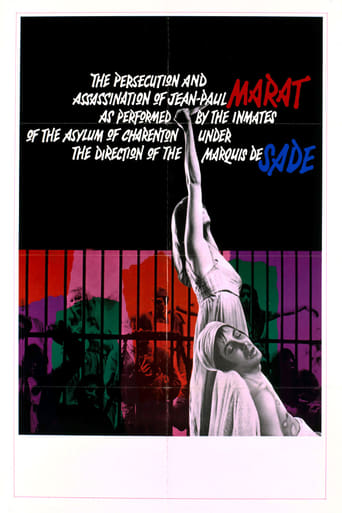Lucybespro
It is a performances centric movie
MamaGravity
good back-story, and good acting
filippaberry84
I think this is a new genre that they're all sort of working their way through it and haven't got all the kinks worked out yet but it's a genre that works for me.
Bob
This is one of the best movies I’ve seen in a very long time. You have to go and see this on the big screen.
jawi-916-6704
Read the Peter Weiss play, and you'll find it to be a brilliant, multilayered, and meaningful work of art. The Peter Brook movie of it is anything but, and it helps to explain the downturn in highbrow British film c. 1967-1974. Peter Brook's baleful influence had to have encouraged the nihilistic pretentiousness of "A Clockwork Orange," "The Ruling Class," and all of Ken Russell.1. Grotesque ugliness for its own sake. Brook and his makeup artists have a field day with drooling "crazies" and perfectly elocuting clown-face choruses. If you've ever wanted to see Brad Pitt's performance in "Twelve Monkeys" multiplied by 20, by all means watch this movie.2. Allegedly good actors horrendously overacting: Glenda Jackson, Patrick Magee, Freddie Jones, and Ian Richardson (he of the unblinking stare) are all terrible.3. Maddening, gimmicky cinematography: fish-eye lens, blaring overexposed white light, blurriness.4. The worst nightmare sequence ever, added by Brook.5. A stupidly violent conclusion that also departs from Weiss.Basically the movie is for pseudo-intellectuals who are looking for a way to slum it whilst still claiming highbrow credentials. Read the play instead.
wolfenzero
Part of the reason what makes this movie so unique is the actors & actresses having to act like their in a asylum and from what conditions they (inmates/patients) have and to act with those conditions. this movie really moved me it was so realistic like i was there. the camera work played the eyes of what you saw as not all inmates had really a role they were the background sound effects or group to in-act the story as they were in a steamer room/wash room and the room was well used. once in a while as the actors inmates characters comes out of character and towards the end of the movie the inmates becomes out of control. you got to like it as De Sade plays as play director. DID they really have Woman and Men Together in a Insane Asylum back in the early 19th century? I didn't know there was piping like that in the steam room/washroom back in 1808.? OH by the way one of the three narrator's looks like gram-pa from the the TV series the Munsters as this movie was made in 1967 it could very well be if you like plays or poetry or a rhythmics acting this is a movie for you
T Y
I'm surprised that this rated so high and receive such universal praise. It's virtually unwatchable in terms of mainstream entertainment and shouldn't have found any audience to appreciate it. It's shrill, endless and stagey.But it's conceits (The context and meaning of the murder of French Revolutionary figure Marat by Charlotte Corday, enacted as a play by post-revolutionary mental patients & penned by the similarly imprisoned Marquis de Sade) are unique and provocative. The play within the play has musical numbers; a trifle given to Corday (Glenda Jackson) as de Sade supplies her with the murder weapon is really nice; "...but love meant something... to you, ...I see, and something much different to me..." The bench duet between Charlotte and her sex-crazed nemesis is memorable.You will need a working understanding of the major players of the French Revolution and a willingness to listen to Marat expound on political theory at length. I own the DVD and even I can't sit through the damned thing. I also really hate some of the typical thespian casting (the all-clown Greek chorus giving it their all is excruciating) but I pop it in now and again to watch it in twenty-minute bursts. There's plenty to think about and though the Bourgeoisie are clearly portrayed as villainous swine, it still doesn't offer any easy answers to the long, painful aftermath of the French Revolution.Sadly, Patrick McGhee (A Clockwork Orange) is the type of leading man who would never again be seen after the advent of focus-groups and the blockbuster. What teen wants to look at anyone over thirty on screen?Les Miz is shallow cream pie compared to this.
middleburg
When Marat/Sade was first shown--those of us used to the traditional Hollywood film entertainments were just stunned. What a tour de force of acting, story, makeup, style, filming and music. We didn't know what to make of it. On the one hand it was the scariest, most disturbing film we had seen, on the otherhand it was a grand entertainment with absolutely intriguing characters. Was it historically accurate? Is it a dream? Was that really supposed to be theMarquis de Sade up on the screen? The film has amazing bookends: Theopening film credits appearing in complete silence one word at a time and then disappearing one word at a time, has to be sort of a classic of film titles-- anticipating the minimalist art movements in the visual arts. Before the film even begins, we are off kilter, completely disoriented. The horrifying ending at the time was a shocker. One is really unprepared for this spectacular brutality--and the fact that it just ends in the midst of the chaos with zero resolution again is totally disorienting. This remains a great film--with some of the most amazing acting ever caught on screen. For most of us here in the U.S., it was the first time we saw Glenda Jackson. Her voice, her presence, her amazing actingtechnique--she became instantaneously recognized as one of the great screenactresses. And sure enough shortly thereafter, she won her two academyawards. If you enjoy great theatre, and great film treatments of theatricalmaterial--this film is simply not to be missed.

